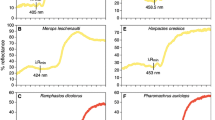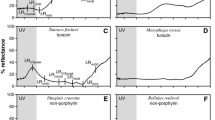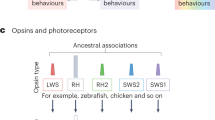Abstract
Among birds, single cone sensitivities responsible for color vision appear surprisingly conserved even though chromatic signals vary greatly. Thus it is widely held that avian visual signal and receptor characteristics are rarely aligned. Analysis of a diverse passerine clade (Passerida) with characteristically ultraviolet-sensitive (UVS) vision revealed that plumage carotenoid reflectance spectra matched cone maximal sensitivities at several levels: (1) plumage carotenoid reflectance minima and maxima in aggregate aligned with the four UVS single cones; (2) the corresponding reflectance features of yellow (hydroxy- and ε-keto) and red (3- and 4-β-keto) carotenoid classes aligned with different combinations of cones; (3) pairs of reflectance features (e.g. one minimum and one maximum) of each carotenoid class aligned with pairs of (opponent) cones that evoke chromatic perception; (4) passerid plumage carotenoids aligned more closely to their own (UVS) visual system than to the distinctive homologous cone classes of the violet-sensitive system found in other birds. The ubiquitous occurrence of plumage carotenoids ipso facto demonstrates that alignments of avian visual signals and receptors are widespread, and provides novel evidence that carotenoids are important to avian communication. Moreover, alignment of different physical spectra to different cone combinations in a fixed receptor array provides a straightforward mechanism that accommodates signal diversity within the context of a relatively conserved visual system. The distinct patterns of variation and alignment observed for yellow versus red carotenoids further suggest that these pigment classes convey different physical aspects of content, which may foster carotenoid-based plumage diversity through signal design trade-offs.







Similar content being viewed by others
References
Andersson, S., & Prager, M. (2006). Quantifying colors. In G. E. Hill & K. J. McGraw (Eds.), Bird coloration (Vol. I, pp. 41–89). Cambridge: Harvard University Press.
Armenta, J. K., Dunn, P. O., & Whittingham, L. A. (2008). Effects of specimen age on plumage color. Auk, 125, 803–808.
Beason, R. C., & Loew, E. R. (2008). Visual pigment and oil droplet characteristics of the bobolink (Dolichonyx oryzivorus), a New World migratory bird. Vision Research, 48, 1–8.
Bennett, A. T. D., Cuthill, I. C., Partridge, J. C., & Lunau, K. (1997). Ultraviolet plumage colors predict mate preferences in starlings. Proceedings of the National Academy of Sciences of the United States of America, 94, 8618–8621.
Bleiweiss, R. (2004). Novel chromatic and structural biomarkers of diet in carotenoid-bearing plumage. Proceedings of the Royal Society of London. Series B: Biological Sciences, 271, 2327–2335.
Bleiweiss, R. (2005). Variation in ultraviolet reflectance by carotenoid-bearing feathers of tanagers (Thraupini: Emberizinae: Passeriformes). Biological Journal of the Linnean Society. Linnean Society of London, 84, 243–257.
Bleiweiss, R. (2007). On the ecological basis of interspecific homoplasy in carotenoid-bearing signals. Evolution; International Journal of Organic Evolution, 61, 2861–2878.
Bleiweiss, R. (2008). Phenotypic integration expressed by carotenoid-bearing plumages of tanagers (Thraupini: Emberizinae) across the avian visual spectrum. Biological Journal of the Linnean Society Linnean Society of London, 93, 89–109.
Boughman, J. W. (2001). Divergent sexual selection enhances reproductive isolation in sticklebacks. Nature, 411, 944–948.
Brambilla, L., Canali, G., Mannucci, E., Massa, R., Saino, N., Stradi, R., et al. (1999). Colori in volo. Il piumaggio degli ucelli ricerca scientifica e cultura umanistica. Università degli studi di milano Hoepli.
Brush, A. H. (1990). Metabolism of carotenoid pigments in birds. FASEB Journal, 4, 2969–2977.
Butler, M. W., Toomey, M. B., & McGraw, K. J. (2011). How many color metrics do we need? Evaluating how different color-scoring procedures explain carotenoid pigment content in avian bare-part and plumage ornaments. Behavioral Ecology and Sociobiology, 65, 401–413.
Carleton, K. L. (2009). The diversity of cichlid vision. Integrative and Comparative Biology, 49, E27.
Carleton, K. L., & Kocher, T. D. (2001). Cone opsin genes of African cichlid fishes: Tuning spectral sensitivity by differential gene expression. Molecular Biology and Evolution, 18, 1540–1550.
Carleton, K. L., Parry, J. W. L., Bowmaker, J. K., Hunt, D. M., & Seehausen, O. (2005). Colour vision and speciation in Lake Victoria cichlids of the genus Pundamilia. Molecular Ecology, 14, 4341–4353.
Changizi, M. A., Zhang, Q., & Shimojo, S. (2006). Bare skin, blood and the evolution of primate colour vision. Biology Letters, 2, 217–221.
Church, S. C., Bennett, A. T. D., Cuthill, I. C., & Partridge, J. C. (1998). Ultraviolet cues affect the foraging behaviour of blue tits. Proceedings of the Royal Society of London. Series B: Biological Sciences, 265, 1509–1514.
Cowing, J. A., Poopalasundaram, S., Wilkie, S. W., Bowmaker, J. K., & Hunt, D. M. (2002). Spectral tuning and evolution of short wave-sensitive cone pigments in cottoid fish from Lake Baikal. Biochemistry, 41, 6019–6025.
Coyle, B. J., Hart, N. S., Carleton, K. L., & Borgia, G. (2012). Limited variation in visual sensitivity among bowerbird species suggests that there is no link between spectral tuning and variation in display colouration. Journal of Experimental Biology, 215, 1090–1105.
Crescitelli, F., McFall-Ngai, M., & Horwitz, J. (1985). The visual pigment sensitivity hypothesis: Further evidence from fish of varying habitats. Journal of Comparative Physiology A, Neuroethology, Sensory, Neural, and Behavioral Physiology, 157, 323–333.
Cuthill, I. C. (2006). Color Perception. In G. E. Hill & K. J. McGraw (Eds.), Bird coloration (Vol. I, pp. 3–40). Cambridge, MA: Harvard University Press.
Doucet, S. M., Mennill, D. J., & Hill, G. E. (2007). The evolution of signal design in manakin plumage ornaments. American Naturalist, 169, S62–S80.
Endler, J. A. (1992). Signals, signal conditions, and the direction of evolution. American Naturalist, 139, S125–S153.
Endler, J. A., & Basolo, A. L. (1998). Sensory ecology, receiver biases and sexual selection. Trends in Ecology & Evolution, 13, 415–420.
Finger, E., & Burkhardt, D. (1994). Biological aspects of bird colouration and avian colour vision including ultraviolet range. Vision Research, 34, 1509–1514.
Frentiu, F. D., & Briscoe, A. D. (2008). A butterfly eye’s view of birds. BioEssays, 30, 1151–1162.
Fuller, R. C., & Noa, L. A. (2010). Female mating preferences, lighting environment, and a test of the sensory bias hypothesis in the bluefin killifish. Animal Behaviour, 80, 23–35.
Goldsmith, T. H., & Butler, B. K. (2003). The roles of receptor noise and cone oil droplets on the photopic spectral sensitivity of the budgerigar. Melopsittacus undulatus. Journal of Comparative Physiology A, 189, 135–142.
Gomez, D., & Théry, M. (2007). Simultaneous crypsis and conspicuousness in color patterns: Comparative analysis of a neotropical rainforest bird community. American Naturalist, 169, 42–61.
Grether, G. (2000). Carotenoid limitation and mate preference in evolution: A test of the indicator hypothesis in guppies (Poecilia reticulata). Evolution; International Journal of Organic Evolution, 54, 1712–1724.
Hart, N. S., & Hunt, D. M. (2007). Avian visual pigments: Characteristics, spectral tuning, and evolution. American Naturalist, 169, S7–S26.
Hart, N. S., & Vorobyev, M. D. (2005). Modelling bird spectral sensitivity from spectrophotometric data: A mathematical model of oil droplet spectral absorption. Journal of Comparative Physiology A, Neuroethology, Sensory, Neural, and Behavioral Physiology, 191, 381–392.
Herrera, G., Zagal, J. C., Diaz, M., Fernández, J., Vielma, A., Cure, M., et al. (2008). Spectral sensitivities of photoreceptors and their role in colour discrimination in the green-backed firecrown hummingbird (Sephanoides sephanoides). Journal of Comparative Physiology A, 194, 785–794.
Hill, G. E. (1996). Redness as a measure of the production cost of ornamental coloration. Ethology Ecology and Evolution, 8, 157–175.
Hill, G. E. (2002). A red bird in a brown bag. The function and evolution of colorful plumage in the house finch. Oxford: Oxford University Press.
Hofmann, C. M., McGraw, K. J., Cronin, T. W., & Omland, K. E. (2007). Melanin coloration in New World orioles I: Carotenoid masking and pigment dichromatism in the orchard oriole complex. Journal of Avian Biology, 38, 163–171.
Honkavaara, J., Koivula, M., Korpimäki, E., Siitari, H., & Viitala, J. (2002). Ultraviolet vision and foraging in terrestrial vertebrates. Oikos, 98, 505–511.
Hörak, P., Ots, I., Vellau, H., Spottiswoode, C., & Møller, A. P. (2001). Carotenoid-based plumage coloration reflects hemoparasite infection and local survival in breeding great tits. Oecologia, 126, 166–173.
Hudon, J. (1991). Unusual carotenoid use by the Western Tanager (Piranga ludoviciana) and its evolutionary implications. Canadian Journal of Zoology, 69, 2311–2320.
Hudon, J., Storni, A., Pini, E., Anciães, M., & Stradi, R. (2012). Rhodoxanthin as a characteristic keto-carotenoid of manakins (Pipridae). Auk, 129, 491–499.
Hurvich, L. M. (1981). Color vision. Sunderland, MA: Sinauer Associates Inc.
Kelber, A., & Osorio, D. (2010). From spectral information to animal colour vision: Experiments and concepts. Proceedings of the Royal Society of London. Series B: Biological Sciences, 277, 1617–1625.
Levine, J. S., & MacNichol, E. F, Jr. (1979). Visual pigments in teleost fishes: Effects of habitat, microhabitat, and behavior on visual system evolution. Sensory Processes, 3, 95–131.
Lipetz, L. E. (1984a). A new method for determining peak absorbance of dense pigment samples and its application to the cone oil droplets of Emydoidea blandingii. Vision Research, 24, 597–604.
Lipetz, L. E. (1984b). Pigment types, densities and concentrations of cone oil droplets of Emydoidea blandingii. Vision Research, 24, 605–612.
Lythgoe, J. N. (1979). The ecology of vision. Oxford: Oxford University Press.
Maan, M. E., & Seehausen, O. (2010). Mechanisms of species divergence through visual adaptation and sexual selection. Current Zoology, 56, 285–299.
McGraw, K. J. (2006). Mechanics of carotenoid-based coloration. In G. E. Hill & K. J. McGraw (Eds.), Bird coloration (Vol. I, pp. 177–242). Cambridge, MA: Harvard University Press.
McGraw, K. J., & Schuetz, J. G. (2004). The evolution of carotenoid coloration in estrildid finches: A biochemical analysis. Comparative Biochemistry and Physiology B, 139, 45–51.
McNett, G. D., & Marchetti, K. (2005). Ultraviolet degradation in carotenoid patches: Live versus museum specimens of wood warblers (Parulidae). Auk, 122, 793–802.
Mollon, J. D., & Regan, B. C. (1999). The spectral distribution of primate cones and of the macular pigment: Matched to properties of the world? Journal of Optical Technology, 66, 847–852.
Mougeot, F., & Arroyo, B. E. (2006). Ultraviolet reflectance by the cere of raptors. Biology Letters, 2, 173–176.
Mullen, P., & Pohland, G. (2008). Studies on UV reflection in feathers of some 1000 bird species: Are UV peaks in feathers correlated with violet-sensitive and ultraviolet-sensitive cones? Ibis, 150, 59–68.
Nagel, M. G., & Osorio, D. (1993). The tuning of human photopigments may minimize red-green chromatic signals in natural conditions. Proceedings of the Royal Society of London. Series B: Biological Sciences, 252, 209–213.
Nakagawa, S. (2004). A farewell to Bonferroni: The problems of low statistical power and publication bias. Behavioral Ecology, 15, 1044–1045.
Ödeen, A., Håstad, O., & Alström, P. (2011). Evolution of ultraviolet vision in the largest avian radiation—The passerines. BMC Evolutionary Biology, 11, 313.
Ödeen, A., Pruett-Jones, S., Driskell, A. C., Armenta, J. K., & Håstad, O. (2012). Multiple shifts between violet and ultraviolet vision in a family of passerine birds with associated changes in plumage coloration. Proceedings of the Royal Society of London. Series B: Biological Sciences, 279, 1269–1276.
Olson, V. A., & Owens, I. P. F. (1998). Costly sexual signals: Are carotenoids rare, risky or required? Trends in Ecology & Evolution, 13, 510–514.
Osorio, D., & Bossomaier, T. R. J. (1992). Human cone pigment spectral sensitivities and the reflectances of natural surfaces. Biological Cybernetics, 67, 217–222.
Osorio, D., Miklosi, A., & Gonda, Z. (1999a). Visual ecology and perception of coloration patterns by domestic chicks. Evolutionary Ecology, 13, 673–689.
Osorio, D., Vorobyev, M., & Jones, C. D. (1999b). Colour vision in domestic chicks. Journal of Experimental Biology, 202, 2951–2959.
Partali, V., Liaaen-Jensen, S., Slagsvold, T., & Lifjeld, J. T. (1987). Carotenoids in food chain studies—II. The food chain of Parus spp. monitored by carotenoid analysis. Comparative Biochemistry and Physiology, 87B, 885–888.
Partrige, J. C. (1989). The visual ecology of avian cone oil droplets. Journal of Comparative Physiology, A, Neuroethology, Sensory, Neural, and Behavioral Physiology, 165, 415–426.
Regan, B. C., Julliot, C., Simmen, B., Viénot, F., Charles-Dominique, P., & Mollon, J. D. (2001). Fruits, foliage and the evolution of primate colour vision. Philosophical Transactions of the Royal Society of London. Series B, Biological sciences, 356, 229–283.
Renoult, J. P., Courtiol, A., & Kjellberg, F. (2009). When assumptions on visual system evolution matter: Nestling colouration and parental visual performance in birds. Journal of Evolutionary Biology, 23, 220–225.
Renoult, J. P., Courtiol, A., & Schaefer, H. M. (2013a). A novel framework to study colour signalling to multiple species. Functional Ecology, 27, 718–729.
Renoult, J. P., Valido, A., Jordano, P., & Martin Schaefer, H. (2013b). Adaptation of flower and fruit colours to multiple, distinct mutualists. New Phytologist. doi:10.1111/nph.12539.
Rodriguez-Amaya, D. B. (2001). A guide to carotenoid analysis in foods. Washington, DC: International Life Sciences Institute Press.
Sabbah, S., Laria, R. L., Gray, S. M., & Hawryshyn, C. W. (2010). Functional diversity in the color vision of cichlid fishes. BMC Biology, 8, 133.
Saks, L., McGraw, K. J., & Hörak, P. (2003). How feather colour reflects its carotenoid content. Functional Ecology, 17, 555–561.
SAS Institute Inc. (2013). SAS users guide, Version 9.1. Cary, NC: On Line Documentation.
Schaefer, H. M., Schaefer, V., & Vorobyev, M. (2007). Are fruit colors adapted to consumer vision and birds equally efficient in detecting colorful signals? American Naturalist, 169, S159–S169.
Shi, Y., & Yokoyama, S. (2003). Molecular analysis of the evolutionary significance of ultraviolet vision in vertebrates. Proceedings of the National Academy of Sciences of the United States of America, 100, 8308–8313.
Slagsvold, T., & Lifjeld, J. T. (1985). Variation in plumage color of the great tit Parus major in relation to habitat, season and food. Journal of Zoology, London (A), 206, 321–328.
Stradi, R., Rossi, E., Rovati, G., & Pastore, M. (1995). Carotenoids in bird plumage—I. The carotenoid pattern in a series of Palearctic Carduelinae. Comparative Biochemistry and Physiology, 110, 131–143.
Sumner, P., & Mollon, J. D. (2000). Catarrhine photopigments are optimized for detecting targets against a foliage background. The Journal of Experimental Biology, 203, 1963–1986.
Vorobyev, M., Osorio, D., Bennett, A. T. D., Marshall, N. J., & Cuthill, I. C. (1998). Tetrachromacy, oil droplets and bird plumage colors. Journal of Comparative Physiology A, Neuroethology, Sensory, Neural, and Behavioral Physiology, 183, 621–633.
Yuan, F. R., Bernard, G. D., Le, J., & Briscoe, A. D. (2010). Contrasting modes of evolution of the visual pigments in heliconius butterflies. Molecular Biology and Evolution, 27, 2392–2405.
Acknowledgments
I thank the American Museum of Natural History (Paul R. Sweet), Delaware Museum of Natural History (Jean Woods), Museum of Comparative Zoology Harvard University (Jeremiah Trimball), University of Michigan Museum of Zoology (Janet Hinshaw), United States National Museum (James Dean), and University of Wisconsin Zoological Museum (Paula Holahan) for generous loans of specimens. William Feeny assisted with the drafting of the figures. The comments by two reviewers contributed to the clarity of the presentation. The National Science Foundation (IOS 0741857) and Vilas Life Cycle Program of the University of Wisconsin (133-PRJ45 EB, 133-PRJ45EC) provided generous financial support of this work.
Author information
Authors and Affiliations
Corresponding author
Electronic supplementary material
Below is the link to the electronic supplementary material.
Appendix: References for Phylogenetic Relationships
Appendix: References for Phylogenetic Relationships
Barker, F. K., Cibois, A., Schikler, P., Feinstein, J., & Cracraft, J. (2004). Phylogeny and diversification of the largest avian radiation. Proceedings of the National Academy of Sciences 101, 11040–11045.
Christidis, L. (1987). Biochemical systematics within Paleotropical finches (Aves: Estrildidae). Auk 104, 380–392.
Craig, A. J. F. (1999). Weaving a story: The relationships of the endemic Ploceidae of Madagascar. In Adams, N.J. & Slotow, R.H. (Eds) Proceedings of the 22nd Interntional Ornithological Congress, Durban (pp. 3063–3070). Johannesburg: BirdLife South Africa.
Ericson, P. G. P. & Johansson, U. S. (2003). Phylogency of Passerida (Aves: Passeriformes) based on nuclear and mitochondrial sequence data. Molecular Phylogenetics and Evolution 29, 126–138.
Hackett, S. J., Kimball, R. T., Reddy, S., Bowie, R. C. K., Braun, E. L., Braun, M. J., Chojnowski, J. L., Cox, W. A., Han, K-L., Harshman, J., Huddleston, C. J., Marks, B. D., Miglia, K. J., Moore, W. S., Sheldon, F. H., Steadman, D. W., Witt, C. C., & Yuri, T. (2008). A phylogenomic study of birds reveals their evolutionary history. Science 320, 1763–1767.
Klicka, J., Burns, K. J., & Spellman, G. M. (2007). Defining a monophyletic Cardinalini: A molecular perspective. Molecular Phylogenetics and Evolution 45, 1014–1032.
Lovette, I. J. Pérez-Emán, J. L., Sullivan, J. P., Banks, R. C., Fiorentino, I., Córdoba-Córdoba, S., Echeverry-Galvis, M., Barker, F. K., Burns, K. J., Klicka, J., Lanyon, S. M., & Bermingham, E. (2010). A comprehensive multilocus phylogeny for the wood-warblers and a revised classification of the Parulidae (Aves). Molecular Phylogenetics and Evolution 57, 753–770.
Zuccon, D., Prys-Jones, R., Rasmussen, P. & Ericson. P. G. P. (2012). The phylogenetic relationships and generic limits of finches (Fringillidae). Molecular Phylogenetics and Evolution 62, 581–596.
Rights and permissions
About this article
Cite this article
Bleiweiss, R. Physical Alignments Between Plumage Carotenoid Spectra and Cone Sensitivities in Ultraviolet-Sensitive (UVS) Birds (Passerida: Passeriformes). Evol Biol 41, 404–424 (2014). https://doi.org/10.1007/s11692-014-9273-8
Received:
Accepted:
Published:
Issue Date:
DOI: https://doi.org/10.1007/s11692-014-9273-8




